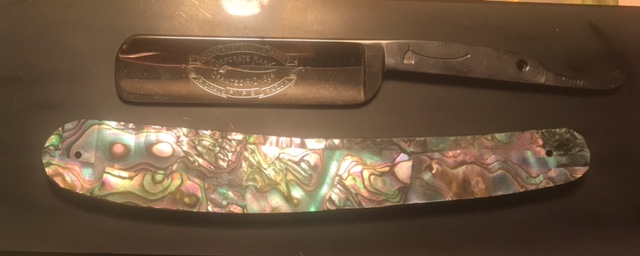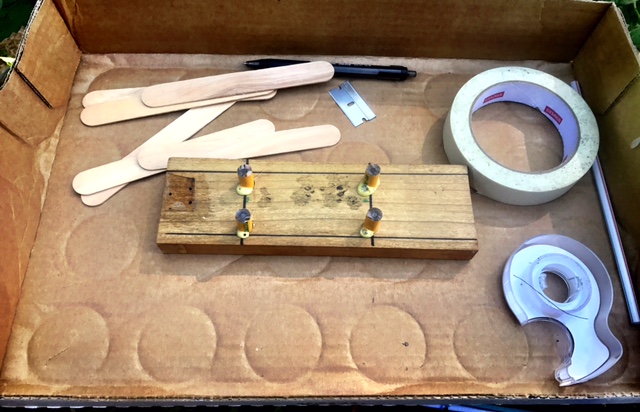Results 1 to 10 of 13
Thread: Question About Epoxy
Hybrid View
-
08-20-2017, 03:05 AM #1
 Question About Epoxy
Question About Epoxy
Okay, so I've been working on this project in my spare timehttp://straightrazorpalace.com/works...n-abalone.html.(See posts #9 and 11).

I plan to put this beautiful Wostenholm Pipe I've been working on in the scales.
At any rate, I got the black acrylic scales shaped and edge-smoothed the way I wanted (think files, followed by wet grinding belts from 400 to 2k to keep the acrylic from melting). I got the abalone veneer cut and adhered to the scale faces without incident (though it is extremely fragile and brittle!). I even managed to smooth and match the veneers to the scale profiles with those same wet belts (whew-wasn't sure that would work!). But because the stuff is so brittle, I decided to forgo the edge beveling this time, as I'm already doing several new techniques here, and I really don't want to screw this up!
I just ordered some FlexCoat rod-builder's epoxy per Mike/Outback's advice. I learned how to set up the scales on ds-taped flat dowels, pour it on, and so forth from our library and other sites. So I have two questions as a 1st-time epoxy user (at least for this application):
1. As I'm worried about sanding dried epoxy off the backs of acrylic scales (worried about melting the insides of the scales), would it be a crazy idea to put a thin coat of some sort of oil on the back flats to keep the epoxy from adhering at all? Would it then drip off? Is this just a totally stupid idea?
2. Can I plug my pin holes with wax or something, then drill back through the cured epoxy? I wanted to pre-drill my holes while I still had masking tape on the abalone, and both sides perfectly flat.
Any advice is appreciated! SHD/Aaron
edit: Oh, and not sure what would make a nice wedge for this? White acrylic? Something light blue or in the teal family? (I guess that's 3 questions lol!).Last edited by ScoutHikerDad; 08-20-2017 at 03:12 AM.
-
08-20-2017, 05:14 AM #2Senior Member




- Join Date
- Feb 2013
- Location
- Haida Gwaii, British Columbia, Canada
- Posts
- 14,457
Thanked: 4830
1) if you masked it with tape it would protect it from getting any spillage on the inside.
In fact it would not hurt to mask the non glue side of both pieces.
2) the epoxy should be really easy to frill out of the hole. In fact you should be able to clean the excess out with a piece of pin wire before it is cured.
Maybe a transparent or translucent wedge would add to your master piece. This is going to look great.It's not what you know, it's who you take fishing!
-
The Following User Says Thank You to RezDog For This Useful Post:
ScoutHikerDad (08-20-2017)
-
08-20-2017, 01:02 PM #3

Rez seems to have you covered, with taping the flats of the inside part of the scales.
As to keeping them from sticking to your work surface, there are two ways that come to mind, that I use.
1. Put wax paper down on your work surface.
2. Build a elevated work surface. I made mine for CA, and oil finishing of wood scales.
Domed some washers, turned them upsidedown, and put a brass brad nail thru them, into a piece of wood. Then roll up a piece of painters tape and fold in half, and place a piece on each dome, tohold the scales in place. This allows me to coat the edges without having the scales becoming glued to my working surface.


Hope this helps.Mike
-
The Following 2 Users Say Thank You to outback For This Useful Post:
ajkenne (08-30-2017), ScoutHikerDad (08-20-2017)
-
08-20-2017, 01:56 PM #4

Thanks Mike and Shaun-This will help me a lot. I will tape the backside. And Shaun-I ordered some inexpensive flat(ish) 25mm malachite beads from Ebay last night for a wedge to accent the paua's green/blue color swirls.
-
08-20-2017, 05:37 PM #5

Wax is commonly used as a mold release for epoxy parts. Dedicated waxes such as Part All are used but I'm told and believe that Johnson's or any furniture or car wax will work fine. Incidentally duct tape works well as a mold release when you aren't concerned with the finish. Since you are not molding this may all be mute, but a coat of wax where you don't want epoxy to stick is a simple precaution.
-
The Following 2 Users Say Thank You to bluesman7 For This Useful Post:
ajkenne (08-30-2017), ScoutHikerDad (08-20-2017)
-
08-20-2017, 05:53 PM #6

Hmm. Interesting.!
Are the molds cooled somehow.?
Most epoxies create heat of some degree, through chemical reaction to each other.
And how much hardener you add.[emoji38]
I would worry that the thin layer of wax, wouldn't hold up under the heat, or possibly the chemicals that make up the epoxy, would eat it away.
Just a curious, measure twice, cut once, KISS, kinda guy. [emoji57]Mike
-
08-20-2017, 06:12 PM #7

I've only used it with relatively thin layups of epoxy/glass, polyester/glass, and on the epoxy/paper micarta that I make, so heat has not been an issue. I'ts a bit scary the first time you rely on it with a mold that you have a lot of work in, but I've never had any problems. As I said there are waxes made specifically as mold releases. I use 'Part All' because I have it. If I were going to use other waxes in a 'must work' situation, a test prior to use would be prudent.
-
The Following 2 Users Say Thank You to bluesman7 For This Useful Post:
outback (08-20-2017), ScoutHikerDad (08-20-2017)
-
08-20-2017, 08:25 PM #8

Victor-Having checked out your beautiful smiling, full-hollow, rattler-spined blades (right in my wheelhouse if I had the cash, by the way!), your technical expertise is obviously beyond my questioning, but let me ask you this? As I'm not doing a mold per se, what about RezDog/Shaun's idea of taping the back (and shaving off the excess flush with the scales obviously)? Seems like I've seen other guys doing it on other sites. One versus the other?
I am currently making a dedicated epoxy/finishing box, and just want to be prepared when my FlexCoat comes in. Thanks-Aaron

-
08-21-2017, 01:08 AM #9Str8Faced Gent.






- Join Date
- Aug 2013
- Location
- Orangeville, Ontario
- Posts
- 8,466
- Blog Entries
- 1
Thanked: 4207
Just to add my own 0.02$, with a self leveling free pour epoxy like Mike suggested I'd go,with the taping the underside as well. I'd use the wider packaging tape, single strip per scale, with scale centered on the tape lengthwise. Tape it down well to the edges, then brush the remaining exposed tape around the scale perimeter, gently bending it away from the scale with your fingertip, on its exposed sticky surface, to allow the epoxy to flow off the scale and down the tape 'slopes' away from the scale as it's held off the work surface. Don't want it to pool along the scale edge before it cures..
This way the edge thickness will not be an issue post cure and with your handy files and a little time, beautiful results to an already awesome looking project.
Hope that makes sense.
Good luck..

And regarding wedge material, a nice slice of bone would work well with the abalone I think.
Look forward to the results!"Depression is just anger,, without the enthusiasm."
Steven Wright
https://mobro.co/michaelbolton65?mc=5
-
08-22-2017, 08:08 PM #10


 39Likes
39Likes LinkBack URL
LinkBack URL About LinkBacks
About LinkBacks







 Reply With Quote
Reply With Quote
